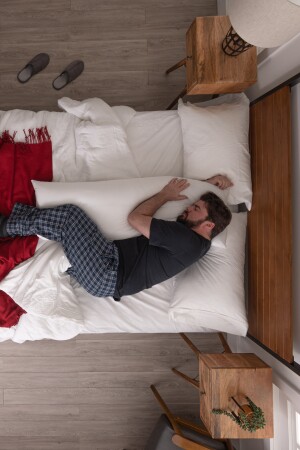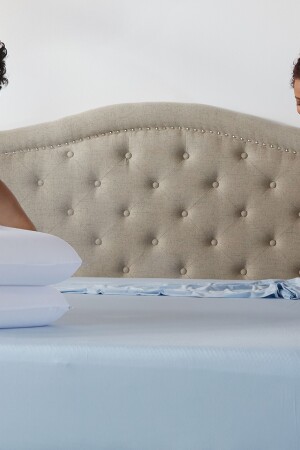How often should you get a new mattress? Probably more often than you think. If you wake up each morning feeling tired, stiff and achy, or you can't remember when you last bought a mattress — it could be time to consider updating your sleep space.
If you're wondering how often you should replace your mattress or how long your current mattress lasts, consider this: mattresses, even high quality Mattress Firm mattresses, are designed to have a lifespan of between five and ten years, though this can vary depending on the type of mattress you have. By planning ahead to “replace every eight," you can avoid sleepless nights caused by a worn-out mattress and have ample time for budgeting and mattress shopping for the perfect replacement.
Mattress Lifespans by Material
Though an average lifespan of five to ten years figure generally holds for most types of mattresses, there can be some variation based on the type of mattress, mattress materials, and whether quality materials went into the construction. Here’s a breakdown of some of the different mattresses on the market:
Innerspring mattresses
Classic spring mattresses unsurprisingly have a common breakdown point around their springs. Too much pressure or enough ongoing wear – even with proper care – can lead to broken springs, which hurt the stability and make the mattress unusable sooner rather than later. An innerspring mattress will typically have a lifespan between 7-8 years.
Latex mattresses
Latex is among the most resilient and durable mattress materials out there. A latex mattress can typically last up to 15 years.
Memory foam mattresses
A good quality memory foam mattress will usually last around 8 to 10 years. This can vary a bit depending on a couple factors. For example, the density of the foam, amount of usage, and level of care and maintenance can all affect the lifespan.
Hybrid mattresses
A hybrid mattress functions similarly to a traditional innerspring mattress, since it’s essentially a combination of an innerspring and a foam mattress mounted on the same bed frame. An average hybrid will tend to last around 7 to 10 years.
5 Signs of When to Replace a Mattress
Wondering how often to replace old mattress accessories and other bedroom necessities shouldn't keep you up at night. Here are a few reasons why it makes sense to get a new bed every eight so you can make sure you're getting the most out of your sleep space:
1. Time = Change
There's no denying our body has probably changed since you last bought a mattress. You may have gained a few pounds or sustained an injury that's still susceptible to pressure. Not to mention how much mattress technology has evolved since your last purchase, updating your mattress to provide maximum support for your body will help you get the sleep you need night after night.
2. Lifestyle Changes
What most people often forget is that changes in your lifestyle may warrant the purchase of a new mattress. The one you're sleeping on now might have belonged to your partner before you met and may not provide you with the support (or space) you need. If you share a bed, it's important to find a mattress that suits both of you. And, if you now have more space available for a bigger bed, it's wise to upgrade to the largest mattress you can afford.
3. Your Bed Is Dirtier Than You Think
All sorts of unwelcome matter tends to collect on mattresses — dead skin cells, body fluids, dust mites, pollen and other allergens. In fact, the accumulation of all this matter may cause your mattress to nearly double in weight after ten years, according to a report by CBS News' “The Early Show." While laundering your linens and vacuuming your mattress regularly is recommended, these particles will still be present and may cause problems for people with allergies. If you or someone you know suffers from severe allergies, we recommend replacing your mattress more frequently, and investing in a high-quality mattress protector or mattress topper.
4. Sleeping with Pain
Morning aches and pains, stiffness, sore muscles, tingling or numbness in your extremities, and feeling groggy and fatigued despite a full night's sleep are all signs of a worn-out mattress. Sleeplessness due to tossing and turning or shifting positions throughout the night is also an indication of a need to replace your mattress. If you suffer from back or neck pain, there are many mattresses that can help you get the rest you need, without sacrificing your savings.
5. Your Mattress Looks Its Age
While changes occur slowly and you may not notice signs of wear in your mattress, it's important to take time regularly to check your mattress for signs of age and wear and tear. Look for lumpy areas, sagging and indentations, all of which can contribute to uncomfortable sleep, and if you notice these signs of aging, it may be time to reconsider your sleep surface.

Don't Ignore the Signs It’s Time to Replace Your Mattress
Because mattresses can be an added expense in many family budgets, people tend to delay their purchase. But, this type of thinking may be penny wise and pound foolish. During a study by Oklahoma State University professor Bert Jacobson, participants indicated they slept much better on new mattresses rather than on their own mattresses, all of which were five or more years old. Better sleep can lead to better health, and might result in fewer doctor visits and prescriptions.
There are a few things you can do to keep from prematurely wearing out your mattress, such as not allowing your children to use it as a trampoline and rotating and turning it every few months to ensure even wear. Additionally, elevating your mattress on box spring can help improve air circulation and stop the kind of moisture buildup that accelerates mattress wear. That said, a mattress that is used daily will most likely still need to be replaced every eight years.
Older adults should consider replacing their mattresses even more often because the aging process causes bodies to become more sensitive to pressure. Many seniors have back pain and joint pain or other health problems that can be alleviated by sleeping on an updated mattress.
A poll conducted by the National Sleep Foundation found that more than 90% of people surveyed said a comfortable mattress is important for a good night’s sleep. Making it a priority to replace every eight will ensure you get quality sleep that contributes to good health and mental well-being.
To find the best bed at the best price, shop our current sale in-store or online today!









